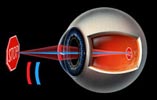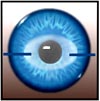The name
"LASIK" is short for Laser In-situ Keratomileusis. LASIK is
used to treat low to high amounts of nearsightedness, astigmatism,
and farsightedness. LASIK combines the computer controlled
precision of the Excimer Laser with the benefits of another
type of refractive surgery called Lamellar Keratoplasty (a
procedure where an instrument known as a microkeratome makes
a small flap in the outer layer of the cornea).
The Excimer laser sculpts the internal corneal tissue to the
correct refractive power in the "steep" axis by flattening
the curvature of the exposed corneal tissue in that axis more
than the other. Light rays are then more directly focused
on the retina in both axis, thereby reducing the
Astigmatism

In
the normal eye, light traveling through the cornea in both
the horizontal plane (blue) and vertical (red) plane is refracted
(bent) the same, so that the image is properly focused on
the retina in the back of the eye. Vision is clear. With astigmatism,
(place cursor over image),
an abnormal curvature of the cornea in one direction causes
light traveling in one plane, the horizontal (blue) plane
in this case, is focused in front of the retina. The light
striking the retina through the horizontal plane is out of
focus on the retina and vision is unclear.
Treatment

The
outer surface of the cornea is treated in such a way with
the Excimer Laser as to effectively "flatten" the cornea in
the steep axis. In the example above, the steep horizontal
axis (blue), is ablated (shaded area) along this axis.
|
|
A
thin corneal flap is created using a special instrument
called a microkeratome |
|
|
The
Excimer Laser pulse, after being preprogrammed for the
appropriate astigmatic correction, reshapes the high axis
(line) of the cornea. |
|
|
The
"flap" is returned to its original position of a quick,
natural recovery. |
|
|
Following
LASIK treatment for astigmatism, the reshaped cornea allows
light rays from viewed objects to be focused on the retina. |
Result
After LASIK Surgery For Astigmatism

Before
LASIK treatment, light traveling in the horizontal meridian
(blue) is out of focus on the retina, in this case. After
LASIK treatment, the reshaped cornea (arrow) causes light
to bend in such a way as to become focused on the retina.
Vision is clear.
Over
96% of patients treated with the LASIK procedure at the Sunetra
Eye Centre are no longer required to wear their glasses or
contacts. However, individual results cannot be guaranteed.
|

